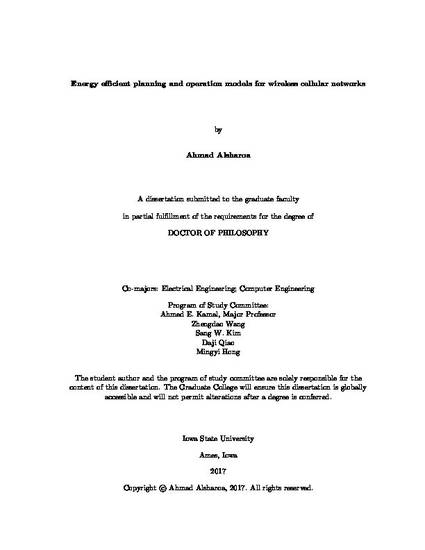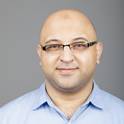
Prospective demands of next-generation wireless networks are ambitious and will require cellular networks to support 1000 times higher data rates and 10 times lower round-trip latency. While this data deluge is a natural outcome of the increasing number of mobile devices with data hungry applications and the internet of things (IoT), the low latency demand is required by the future interactive applications such as "tactile internet", virtual and enhanced reality, and online internet gaming, etc.
The motivation behind this thesis is to meet the increasing quality of service (QoS) demands in wireless communications and reduce the global carbon footprint at the same time. To achieve these goals, energy efficient planning and operations models for wireless cellular networks are proposed and analyzed.
Firstly, a solution based on the overlay cognitive radio (CR) along with cooperative relaying is proposed to reduce the effect of the scarcity problem of the radio spectrum. In overlay technique, the primary users (PUs) cooperate with cognitive users (CUs) for mutual benefits.
The achievable cognitive rate of two-way relaying (TWR) system assisted by multiple antennas is proposed.
Compared to traditional relaying where the transmission to exchange two different messages between two sources takes place in four time slots, using TWR, the required number of transmission slots reduces to two slots. In the first slot, both sources transmit their signals simultaneously to the relay. Then, during the second slot the relay broadcasts its signal to the sources.
Using an overlay CR technique, the CUs are allowed to allocate part of the PUs' spectrum to perform their cognitive transmission. In return, acting as amplify-and-forward (AF) TWR, the CUs are exploited to support PUs to reach their target data rates over the remaining bandwidth.
A meta-heuristic approach based on particle swarm optimization algorithm is proposed to find a near optimal resource allocation in addition to the relay amplification matrix gains.
Then, we investigate a multiple relay selection scheme for energy harvesting (EH)-based on TWR system.
All the relays are considered as EH nodes that harvest energy from renewable and radio frequency sources, where the relays forward the information to the sources. The power-splitting protocol, in which the receiver splits the input radio frequency signal into two components: one for information transmission and the other for energy harvesting, is adopted at the relay side.
An approximate optimization framework based on geometric programming is established in a convex form to find near optimal PS ratios, the relays’ transmission power, and the selected relays in order to maximize the total rate utility over multiple time slots.
Different utility metrics are considered and analyzed depending on the level of fairness.
Secondly, a downlink resource and energy management approach for heterogeneous networks (HetNets) is proposed, where all base stations (BSs) are equipped to harvest energy from renewable energy (RE) sources.
A hybrid power supply of green (renewable) and traditional micro-grid, such that the traditional micro-grid is not exploited as long as the BSs can meet their power demands from harvested and stored green energy. Furthermore, a dynamic BS switching ON/OFF combined with the EH model, where some BSs are turned off due to the low traffic periods and their stored energy in order to harvest more energy and help efficiently during the high traffic periods.
A binary linear programming (BLP) optimization problem is formulated and solved optimally to minimize the network-wide energy consumption subject to users' certain quality of service and BSs' power consumption constraints.
Moreover, green communication algorithms are implemented to solve the problem with low complexity time.
Lastly, an energy management framework for cellular HetNets supported by dynamic drone small cells is proposed. A three-tier HetNet composed of a macrocell BS, micro cell BSs (MBSs), and solar powered drone small cell BSs are deployed to serve the networks' subscribers. In addition to the RE, the drones can power their batteries via a charging station located at the macrocell BS site. Pre-planned locations are identified by the mobile operator for possible drones' placement. The objective of this framework is to jointly determine the optimal locations of the drones in addition to the MBSs that can be safely turned off in order to minimize the daily energy consumption of the network. The framework takes also into account the cells' capacities and the QoS level defined by the minimum required receiving power. A BLP problem is formulated to optimally determine the network status during a time-slotted horizon.
Available at: http://works.bepress.com/ahmad-alsharoa/32/
